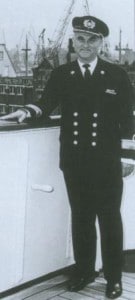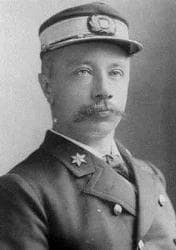Today we sailed along the coast of Mexico, about 10 to 12 miles off, and enjoyed the most perfect weather you can have. The sea was as smooth as can be with only a low rolling swell coming in; the sky was partly cloudy and it could not really have been better. The only thing that marred our perfect day was the presence of six pack navigators, right on our track line. The moment we came close to Zihuatenego they all came racing out. On good weather days the sport fishermen come out to about 15 miles from shore for Marlin and other fishing. I think it has to do with the fact that a bit further to the West we have the Middle American Trench, a sort of canyon under water where the sea depth goes down to about 15,000 ft. that means colder water that is then pushed up from these depths and it brings up nutrients and other things fish really like, and that means Fishermen. That means paying extra attention on the bridge, as they normally don’t. When a fisherman’s mind is on fishing there is not much room left for other thoughts. So we zigzagged safely through the area and then continued unhindered up the coast.
Just after I started blogging again a question came in about why the Senior Captains are not always on the largest ships? This a very good observation because it always used to be the case. If you look at my Old Captains section on the blog site (to which I am still adding), you can invariably see a pattern for promotion and assignments.
As soon as an officer came close to Chief Officer or Staff captain, as assignment pattern established itself. When promoted to chief officer you were sent to the oldest (cargo) ship and then slowly worked your way up to Chief Officer of the flagship. Once there your promotion to Captain meant that you started the process all over again. Until eventually you were the senior captain in the fleet and then you sailed on the flagship, and/or took the newest ship out that was built.
Captain F. Bonjer the first company commodore in 1893. Note: the gold commodore band is on the cap.
In general that pattern was followed consistently from the 1880’s until 1968. In 1968 the Commodore title was abolished as the company focused on cruising and found that this title was really something from the Trans Atlantic days. At the same time the new cargo ships (Atlantic star, Atlantic Crown, Bilderdijk II) were so expensive and important to the company that the distinction of the (passenger) flagship being the ultimate in a sailor’s achievement started to fade. The company sold off the cargo side in 1974 but the change had been made and not always did the most senior captain sail on the largest ship. When the company bought Home Lines in 1988, the picture became much clearer as the Homeric /Westerdam II became the largest ship ever owned by the company. So it should have had the most senior captain on board but it was not the case.
 Capt. A de Jong, the last company commodore in 1958. Note: the gold commodore band is on the sleeves.
Capt. A de Jong, the last company commodore in 1958. Note: the gold commodore band is on the sleeves.
Then with the event of the S, R and Vista-class, the senior captains were for a while on the newest ship coming into the fleet, but with 4 in each class the ships were more or less identical, did similar cruises, and thus the distinction of being on a “senior ship” became totally blurred. By 2000 marketing came up with the idea of having a “flagship class”; the Rotterdam and Amsterdam, and neither of them was commanded by the most senior captain in the fleet.
Around that time the company started with the “team philosophy” e.g. trying to establish groups on board that would work together the best. As each person is different, some work better together than others. So teams were put together and if they worked well together they were left to it and thus a group would stay on the same ship. Sometimes somebody would ask for another ship and/or another route after a few years and then a sort of musical chair thing would happen to make that change possible.
As a result there is absolutely no pattern to who is where. Plus it is difficult to assign seniority nowadays as we have officers, including captains coming in, sideways in rank. So who would be the senior captain in the fleet? The one with the most years as captain ?, the one who has been the longest with the company ?? You tell me.
Tomorrow we are in Puerto Vallarta, and it will be a busy day with three ships. Us coming in first and going to berth 3, then the Sapphire Princess going to berth 1, (she is the biggest and thus she gets what is perceived the best berth) and then the Zaandam, who goes to berth 2. She is staying overnight to facilitate evening tours. Personally I think that berth 2 is still the best as it makes no difference for the tours and it is right opposite Wall-mart which is extremely important for passengers and crew alike. Our berth is also extremely handy as the tour buses are pulling up almost next to the ship.


March 27, 2013 at 5:16 pm
Capt; any idea where the “star” insignia found on the collars on captain uniforms originated? Captain Bonjer already had them in 1893 and they are still being worn by captains today. Thanks!
March 27, 2013 at 8:56 pm
Hello Copper,
yes. Around 1890 the company decided identify the officers rank (no stripes yet) by stars. The 4th. officer had one little star, then 3rd officer two, the 2nd officer 3, the chief officer 4 and the Captain had one big one. The little stars disappeared in 1968, but the big star has remained until today.
Best regards
Capt. Albert
March 27, 2013 at 9:31 pm
Thanks a bunch Capt. 🙂